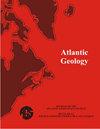Lithostratigraphy and lithogeochemistry of Ediacaran alkaline basaltic rocks of the Musgravetown Group, Bonavista Peninsula, northeastern Newfoundland, Canada: an extensional volcanogenic basin in the type-Avalon terrane
IF 0.9
4区 地球科学
Q2 GEOLOGY
引用次数: 0
Abstract
Volcanic rocks of the Ediacaran Musgravetown Group on Bonavista Peninsula, Avalon terrane, Newfoundland, include basal ca. 600 Ma calc-alkaline basalt succeeded by continental tholeiite and alkaline rhyolite of the ca. 592 Ma Plate Cove volcanic belt (Bull Arm Formation), indicating a change from subduction-related to extensionrelated tectonic regimes during that interval. Alkalic basalts on northeastern (Dam Pond area) and southwestern (British Harbour area) Bonavista Peninsula occur below and above, respectively, the ca. 580 Ma glacial Trinity facies. Dam Pond basalt occurs in a structural dome intercalated with and flanked by fine-grained, siliciclastic deposits (Big Head Formation) overlain by Trinity facies. The British Harbour basalt occurs above the Trinity facies, in an upward- coarsening sandstone sequence (Rocky Harbour Formation) overlain by red beds of the Crown Hill Formation (uppermost Musgravetown Group). The Rocky Harbour and Big Head formations are likely stratigraphically interfingered proximal and distal deposits, respectively, derived from erosion of the Bull Arm Formation and older Avalonian assemblages.The Big Head basalts have lower SiO2, Zr, FeOT, P2O5, TiO2 and higher Mg#, Cr, V, Co and Ni contents, and are therefore more primitive than the more FeOT-, TiO2-, and P2O5-rich British Harbour basalts. Large-ionlithophile and rare-earth-element concentrations and ratios indicate that both suites originated from low degree partial melts of deep, weakly garnet-bearing, undepleted asthenospheric peridotite sources, with magma conduits likely focused along regional extensional faults. The protracted and episodic extension-related volcanic activity is consistent with a geodynamic setting that evolved from a mature arc into extensional basins with slowly waning magmatism, possibly involving slab rollback and delamination followed by magmatic underplating. The duration and variation of both volcanism and sedimentation indicate that the Musgravetown Group should be elevated to a Supergroup in order to facilitate future correlation of its constituent parts with other Avalonian basins.加拿大纽芬兰东北部Bonavista半岛Musgravetown群Ediacaran碱性玄武岩岩石地层学与岩石地球化学:阿瓦隆型地体中的一个伸展火山盆地
纽芬兰阿瓦隆地体Bonavista半岛Edacaran Musgravetown群的火山岩包括基底约600 Ma的钙碱性玄武岩,之后是大陆拉斑玄武岩和约592 Ma的Plate Cove火山带的碱性流纹岩(Bull Arm组),表明在该时期,俯冲与伸展相关的构造机制发生了变化。Bonavista半岛东北部(Dam Pond地区)和西南部(British Harbour地区)的碱性玄武岩分别出现在约580 Ma冰川三位一体相的下方和上方。坝塘玄武岩出现在一个结构圆顶中,该圆顶夹有细粒硅化碎屑沉积物(大头组),两侧覆盖着Trinity相。British Harbour玄武岩产于Trinity相之上,呈向上变粗的砂岩序列(Rocky Harbour组),上面覆盖着Crown Hill组(Musgravetown群最上层)的红色层。Rocky Harbour和Big Head地层可能分别是地层交错的近端和远端矿床,源于Bull Arm地层和较老的Avalonian组合的侵蚀。大头玄武岩的SiO2、Zr、FeOT、P2O5、TiO2含量较低,Mg#、Cr、V、Co和Ni含量较高,因此比富含FeOT-、TiO2和P2O5的英国港玄武岩更原始。大的亲离子岩石和稀土元素浓度和比例表明,这两个岩套都起源于深部、弱含石榴石、未完全的软流圈橄榄岩源的低程度部分熔融,岩浆通道可能集中在区域伸展断层上。与伸展相关的长期和幕式火山活动与从成熟弧演化为伸展盆地的地球动力学背景一致,岩浆作用缓慢减弱,可能涉及板块回滚和分层,然后是岩浆底侵。火山活动和沉积的持续时间和变化表明,Musgravetown群应被提升为超群,以促进其组成部分与其他阿瓦隆盆地的未来相关性。
本文章由计算机程序翻译,如有差异,请以英文原文为准。
求助全文
约1分钟内获得全文
求助全文
来源期刊

Atlantic Geology
GEOLOGY-
CiteScore
2.10
自引率
18.80%
发文量
0
审稿时长
>12 weeks
期刊介绍:
Atlantic Geology (originally Maritime Sediments, subsequently Maritime Sediments and Atlantic Geology) covers all aspects of the geology of the North Atlantic region. It publishes papers, notes, and discussions on original research and review papers, where appropriate to the regional geology.
 求助内容:
求助内容: 应助结果提醒方式:
应助结果提醒方式:


